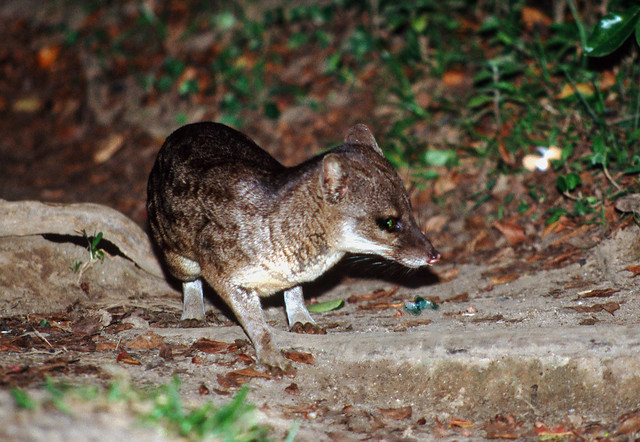Fossa fossana Cladus: Eukaryota Name Fossa fossana (Müller, 1776) References * Fossa fossana on Mammal Species of the World.
The Malagasy or striped civet (Fossa fossana), also known as the fanaloka (Malagasy, [fə̥ˈnaluk]), is a rare euplerid endemic to Madagascar.[2] Previously, the Malagasy Civet was placed in the subfamily Hemigalinae with the banded palm civets and then in its own subfamily, Fossinae, but it is now classified as a member of the subfamily Euplerinae. It has also been classified Fossa fossa. It should not be confused with the fossa (common name), a similar animal also endemic to Madagascar, which has the scientific name Cryptoprocta ferox. Nor is it the same as the related—and similarly named—Malagasy carnivore the falanouc, which is also a euplerine. It is a small mammal: about 47 cm excluding the tail (which is only about 20 cm) and 2.5 kg. It has the appearance and movements of a small fox. It has a short coat greyish beige in colour, with dark black horizontal stripes running from head to tail, where the stripes are vertical, wrapping around the bushier tail. The stripes morph into spots near the belly. Its legs are short and very thin. The sources disagree over whether its claws are retractile. It has no anal glands, unlike other civets. It is endemic to the tropical forests of Madagascar, and specifically can be found in the Madagascar dry deciduous forests. It is nocturnal, though sources disagree over whether it is solitary or, unusual among euplerids, lives in pairs. It is not a good climber and frequents ravines. It eats small vertebrates (mammals, reptiles, and amphibians), insects, and eggs stolen from birds' nests. The mating season of the Malagasy Civet is August to September and the gestation period is three months, ending with the birth of one young. The young are rather well-developed, with opened eyes, and they are weaned in 10 weeks. Little else is known due to its rarity, it may be naturally rare or it may be greatly affected by human endeavours. References ^ Hawkins, A.F.A. (2008). Fossa fossana. In: IUCN 2008. IUCN Red List of Threatened Species. Downloaded on 22 March 2009. Database entry includes justification for this species is of near threatened. Sources Macdonald, David (ed). The Encyclopedia of Mammals. (New York, 1984)
Source: Wikipedia, Wikispecies: All text is available under the terms of the GNU Free Documentation License |
|


